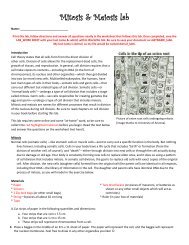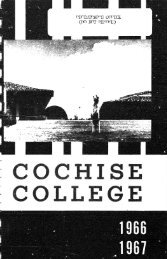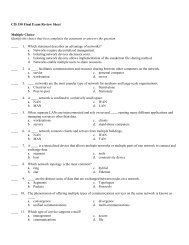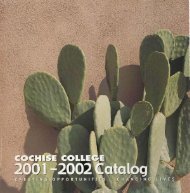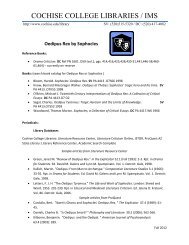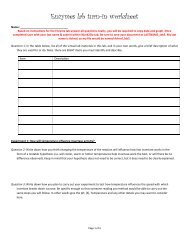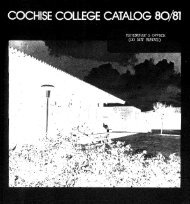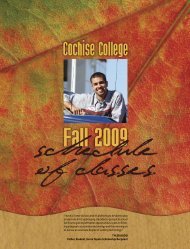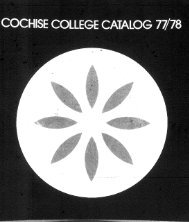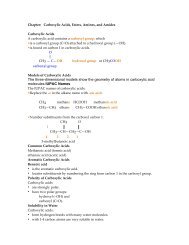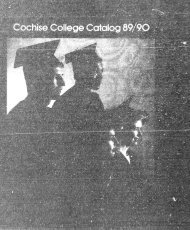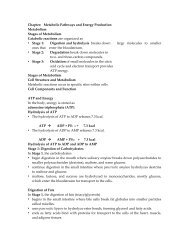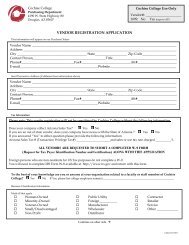BIO-156 General Biology for Allied Health - Cochise College
BIO-156 General Biology for Allied Health - Cochise College
BIO-156 General Biology for Allied Health - Cochise College
You also want an ePaper? Increase the reach of your titles
YUMPU automatically turns print PDFs into web optimized ePapers that Google loves.
<strong>BIO</strong> <strong>156</strong>Tasneem AshrafCourse syllabus Fall 2009<strong>BIO</strong>-<strong>156</strong> <strong>General</strong> <strong>Biology</strong> <strong>for</strong> <strong>Allied</strong> <strong>Health</strong>INSTRUCTOR: TASNEEM ASHRAFhttp://skywalker.cochise.edu/ashraft/web/index.htmlCLASS HOURS: Lecture / laboratory / Time: Tuesday @ 9:15‐ noonCONTACT: 515‐5340 (work, SV office) Best way to reach me is by email.E‐mail: ashraft@cochise.eduOFFICE HOURS: Room # 117 All times are <strong>for</strong> SV campus, unless otherwise noted.Monday: 10:00 am to 2 pm. Tuesday: 12 noon to 2 pmWednesday 12:45 pm to 1:45 pm (Benson campus) and Thursday: 10am to 2 pmREQUIRED MATERIALS:(a) “<strong>Biology</strong>” by Sylvia Mader, Custom Edition. (from 10 th edition)(b) “<strong>General</strong> biology <strong>for</strong> allied health” :Lecture/ laboratory Packet by Tasneem Ashraf, <strong>Cochise</strong> <strong>College</strong>Available at the bookstore; price reflects cost of printing only.(c) Clicker (electronic keypad) – buy at bookstore, register online by following instructions that comewith the clickers and using the class key provided on the first day of class.WORKLOAD:In college, <strong>for</strong> each credit hour, it is expected that students will work two or more hours a week outside ofclass time in preparation <strong>for</strong> class. This means that <strong>for</strong> a typical 4 credit hour course, you would expect tospend eight hours a week in prep time outside of class. Lab credits generally require more work than nonlabcredits. To succeed, you will need to be prepared to spend adequate time on this class. The amount oftime actually spent will depend upon your background, study habits and goals.COURSE DESCRIPTION:Catalog Description: An introductory biology course <strong>for</strong> allied health majors with an emphasis on humans.Topics include fundamental concepts of biology, chemistry, cell biology, histology, microbiology andgenetics.COURSE WEBSITE:Go to www.cochise.edu and then click on Online Instructions. Select the WebStudy links and login. Youshould be automatically enrolled in this class. If you are not, contact Tasneem. Please make sure you have avalid, current email address listed on your preferences so Tasneem can contact you!! If you don’t have anemail address, go to the library, get on Internet and create a free email account through a free website such as <strong>Cochise</strong><strong>College</strong>, Hotmail, Yahoo etc. Ongoing announcements will be posted in the announcement folder ‐ veryimportant <strong>for</strong> you to check the announcements regularly. (At least three times a week)TRANSFERABILITY:Transfers as elective to ASU, NAU and U of A. The nursing AAS require <strong>BIO</strong> <strong>156</strong> as a prerequisite <strong>for</strong> <strong>BIO</strong> 201.1
<strong>BIO</strong> <strong>156</strong>Tasneem AshrafCourse syllabus Fall 2009COURSE RECOMMENDATIONS:You will be required to do college level work‐ this level of per<strong>for</strong>mance is absolutely mandatory; a readinglevel of 110 or exemption, MAT 82 or placement in, or completion of MAT 122 or higher would berecommended.Course Specific Outcomes: Students will be able to:1. Per<strong>for</strong>m activities to demonstrate improvement in the general education goals of communication and criticalthinking.2. Demonstrate biology study skills necessary <strong>for</strong> anatomy and physiology.3. Identify key components of the scientific method and apply the scientific process.4. Demonstrate the ability to safely use biological laboratory techniques.5. Demonstrate the correct use of a light microscope, metric tools <strong>for</strong> measuring length, mass, and volume, andlaboratory safety skills.6. Describe and give examples of life’s hierarchy of organization.7. Compare and contrast prokaryotes, eukaryotes and viruses.8. Explain the basic chemical processes of life.9. Describe the four categories of “macromolecules” and why each is important <strong>for</strong> cellular structure and functions.10. Explain how enzymes function.11. Describe the structure of the cellular organelles and how each functions.12. Describe specifically membrane transport mechanisms, protein synthesis and packaging, and anaerobic andaerobic cellular respiration.13. Describe the cell cycle, mitosis and meiosis.14. Describe the principles of Mendelian Genetics.15. Describe and give examples of the primary human tissues, and where in the body each can be found.16. Demonstrate knowledge of the human body and orientation terms used to describe position.17. Describe the principles of biological chemistry.18. Describe the concepts of evolution and natural selection as they apply to human diseases (e.g. antibioticresistance).COURSE LOGISTICS:Online participation and completion of electronic assignments. This web‐enhanced version of <strong>BIO</strong> <strong>156</strong> aims tohelp you become an independent learner. Since nearly all lectures will not take place during class time, you willneed to be able to access the internet so that you can complete the assigned weekly lectures be<strong>for</strong>e coming toclass. All electronic lectures are available to view and listen to on your computer or to listen to on your mp3player. You will need to have access to a computer and the internet and are expected to login within 48 hoursafter your class meets face‐to‐face each week to check announcements and assignments. You must also completeall online assignments and listen to all audio/visual lectures each week (no waiting until end of semester—eachassignment/lecture has an absolute, posted due date).1. Quizzes and Examinations: (a total of 55 % of the course grade):a. PREP QUIZZES: (10% of the course grade). PREP quizzes are planned <strong>for</strong> each class meet, unlessthere is a test scheduled <strong>for</strong> that day. All prep quizzes will be given at the beginning of each classperiod to ensure you have the read the new chapter and are ready <strong>for</strong> class lecture. There’s a second2
<strong>BIO</strong> <strong>156</strong>Tasneem AshrafCourse syllabus Fall 2009benefit to frequent quizzing: the more you spread out your learning and review of material, themore likely you are to remember the in<strong>for</strong>mation and retain it over time. Consult the courseschedule to anticipate what chapters you need to read <strong>for</strong> the coming class. Prep (clicker) quizzeswill be multiple choices and you will take them with your clicker. Each prep quiz will be worth 10points. Quizzes cannot be made‐up. . When final grades are calculated, I will drop two of yourquizzes towards your total final grade calculations.b. EXAMINATIONS: (45% of the course grade): Five examinations will be given during the semester.The exam includes a multiple‐choice section with somewhere between 25 and 35 multiple choicequestions, as well as a short answer section (consisting of short essay, fill‐in‐the‐blank, labelingillustrations, etc.). You must answer all essay questions with complete sentences or you will lose points.EXAM I (<strong>Biology</strong>, atoms and molecules and macromolecules)EXAM II (evolution, cell structure and function, membrane and transport)EXAM III (metabolism, cellular respiration, mitosis and meiosis)EXAM IV (genetics, DNA structure and replication)FINAL EXAM (Comprehensive includes 40% of protein synthesis, histology, mechanism ofevolution and 60% from the previous four exams.)c. Lecture exam TEST CORRECTIONS:You may correct lecture exams one through four to add up to 10% of the total value of the exam to youroriginal score. Students have until the next class after receiving their graded exam to make corrections.For example: If a test is worth 100 points then the correction rubric is as follows:Short answer portion: A student may earn a maximum of 5 pts. If s/he correctly re‐answer all missedparts of his/her short answer portion. If a student correctly re‐answers 80% of the questions she missed,I will add 0.80 X 5 pts = 4 points to her grade. If another student only correctly re‐answers 30% of thequestions he missed, I will add 1.5 points (5 pts X 0.30 = 1.5) to his grade. A student may not improvehis/her grade in excess of 100%.Multiple choice portion: A student may earn a maximum of 5 pts. if s/he correctly re‐answer all parts ofhis/her multiple choice portion. For example, if you correctly answer 95% of the multiple choicequestions on the take‐home portion, I will multiple 5 by 0.95 to determine that you will have 4.75 addedto your exam score.If you miss an exam, you lowest grades from another exam will be substituted and you can’t do testcorrections.See the “Correcting Tests” handout in this lecture packet <strong>for</strong> detailed2. Homework: (20% of the course grade) you have assigned homework <strong>for</strong> each week under WebStudy.WebStudy assignments are available from the beginning of the semester however they will endTuesdays at 11PM <strong>for</strong> each week assigned. You cannot make up any missed assignments, so please getinto the habit of taking assignments on time, no exceptions will be made! Also in mind, that you cantake the quizzes multiple times however ONLY THE LAST ATTEMPT WILL BE IN YOUR GRADEBOOK. For example you took the quiz the second time and you think you did okay, but want to go backand retake it, however now <strong>for</strong> any reason you decide not to complete it. Now your new grade is basedon this last attempt and any question you did not answer gets a zero assigned automatically.3
<strong>BIO</strong> <strong>156</strong>Tasneem AshrafCourse syllabus Fall 20093. Laboratory: (15 % of the course grade) you are expected to come to laboratory having read that day’sexperiments and having a general idea of what you will be doing. The detail lab write‐ups/data sheetsare due the next weekday following the completion of the experiment. If you miss any part of myintroduction to a given experiment, which I consider important to your (and my) safety, then you willnot be permitted to do that experiment. If you leave early during a lab and do not complete yourexperiment, then you will receive a zero <strong>for</strong> that experiment. Laboratory data sheets turned in late willhave 10% of the grade deducted. When final grades are calculated, I will drop 1 lab grade.4. Classroom response system <strong>for</strong> participation (5% of the course grade): We will use clickers in class on adaily basis‐ even on test days. You will also need them to take quizzes, as well during classparticipation and responses in‐class questions. There<strong>for</strong>e, you must remember to bring clickers to classevery day.• If you <strong>for</strong>get to bring your clickers on the day of the quiz or exams, you will be allowed on twooccasions only to turn in handwritten sheets, which I will grade manually. If you <strong>for</strong>get to bringyour clicker on the day <strong>for</strong> class participation, you will not be allowed to submit handwritten sheets.• You will receive points <strong>for</strong> class participation, with your clicker throughout the semester and willearn a total number of points, out of 30 semester’s end <strong>for</strong> participation. You will receive points <strong>for</strong>trying to answer the question and not be penalized <strong>for</strong> incorrect answer.5. Final project: (5 % of the course grade) you may pick from any one of the following delivery mode todemonstrate your understanding of any topic that interests you during the semester. You will work in agroup of three, and plan your projects accordingly. The group will lead class towards discussion andexplanation <strong>for</strong> the assigned week’s topic. A grading rubric will also be provided.• Presentation:You will be required to use the library to research a human genetic disease thought to be caused by amutation in a single gene. Ask me if you want to do this, I will give you a handout as guidance on thissection. The topic should cover key concepts or models or hypothesis or theories and facts which youhave learned during this class.• Experimental Design:You will be required to design and carry out a scientific experiment then present the results to the class.The presentation is structured similar to a journal article and have of six parts: an abstract, introduction,materials and methods, results (experimental design only), discussion, and reference section.• Interactive Model:You will be required to design an interactive model of one of the concepts we will be learning about inclass this semester. In addition you will be required to turn in an outline and present your model to theclass.MAKE‐UPS TESTS: If you miss an Exam, your missed grade will be substituted by the lowest pointsearned from the other given exams.• Your ONE lowest Exam grade will be dropped at the time when Final Grades are calculated.ACADEMIC HONESTY: Cheating and plagiarism are unethical. Students are expected to do their ownwork. Students must present ideas in their own words or give proper credit to original sources if text is4
<strong>BIO</strong> <strong>156</strong>Tasneem AshrafCourse syllabus Fall 2009used verbatim from any outside sources. If students work together on an assignment, they must type theiranswers separately. Plagiarism is the use of another person’s words and/or ideas without adequateacknowledgment. This includes copying or cutting and pasting from online sources, taking in<strong>for</strong>mationfrom a book or article, copying someone else’s paper, or having someone else do your work <strong>for</strong> you. When astudent uses research sources, those sources must be properly documented. Students found cheating orintentionally plagiarizing will receive a zero <strong>for</strong> the assignment and may be dismissed from the class with afailing grade. Plagiarism will not be tolerated by Tasneem!!!!GRADING POLICY:On all work done in the class; grades will be assigned on the following basis:GRADE SCALE: A = 90%‐and above, B = 80%‐89%, C = 70%‐79%, D = 60%‐69%, F = below 60%Grade Standards—<strong>for</strong> <strong>Cochise</strong> <strong>College</strong>A: The highest academic grade possible; an honor grade which is not automatically given to a student whoranks highest in the course, but is reserved <strong>for</strong> accomplishment that is truly distinctive and demonstrablyoutstanding.B: A grade that denotes achievement considerably above acceptable standards and mastery of coursematerialsC: Indicates a satisfactory degree of attainment and is the least acceptable standard <strong>for</strong> graduation fromcollege or additional studies within the discipline. This grade implies completion of the minimum outcomesidentified in the course curriculum.D: Denotes a limited understanding of the subject matter, meeting only the minimum requirement <strong>for</strong>passing the course. This grade will not transfer to another institution of higher education nor is it acceptable<strong>for</strong> additional studies within the discipline.F: Indicates inadequate or unsatisfactory attainment, serious deficiency in understanding of course material,or failure to complete requirements of the course.Accessing grades online:I use Snapgrade separate grading software. I will be sending you an email from snap grade(https://snapgrades.net/) with instructions on how to log in within this online grade book sometimes by thesecond week of the semester. Periodically grades will be transferred from WebStudy to Snapgrade. Pleasenote that as soon as you enter an assignment, online test, <strong>for</strong>um, WebStudy assignments I cannotautomatically grade it. Many assignments require <strong>for</strong> me to read and review be<strong>for</strong>e I can assign a grade.Since I am teaching four science classes allow about a week after the deadline <strong>for</strong> these to be posted.Attendance policy: Attendance will be taken at the beginning of each class meeting. Tardiness is highlydisruptive and annoying. In an intensive course like this one attending each lecture is very important, aseven one absence can cause you to be behind the rest of the class. After four (4) absences I will reserve theright to drop you from the course. There are no make‐up laboratories and there<strong>for</strong>e you are not allowed tomiss a laboratory without penalty. I will assign a zero to any missed lab. If you miss a class it is yourresponsibility to obtain notes, and or supplementary materials by visiting the WebStudy website, contactingother students, or come see me.5
<strong>BIO</strong> <strong>156</strong>Tasneem AshrafCourse syllabus Fall 2009EMAIL COMMUNICATION AND ONLINE WRITTEN ETIQUETTE:Please use <strong>BIO</strong> <strong>156</strong> in any communication to me in the subject matter, I teach about 3‐4 sections and it ishard <strong>for</strong> me to know exactly what your situation maybe be that needs attention. This is a college class.Proper English is required and expected. All sentences you write in emails and in online discussions <strong>for</strong>this course must abide by the following criteria.a. You must use complete sentences. This means start with a capital letter, contain at least a noun averband must end with a proper appropriate punctuation mark.b. Writing all words in lower case is unacceptable.c. Do not write in all capital letters unless your intention is to yell at your recipient, as messages in allCapital letters are construed as yelling.The pronoun “I” must be capitalized in all uses.d. The pronoun “you” must be spelled y‐o‐u and not “u”.e. All other words must be spelled correctly and in their entirety.f. Please refresh your memory on the differences between there/their/ they’re, to/ two/too and its/it’ssoThat your use.g. All emails must be signed with your name and make sure you mention the exact class you areenrolled in.NOTE:Your success in this class is up to YOU. I am here to help you understand difficult material, but it isyour responsibility to read assigned material, to take notes while listening to the audio (wmv files) lecturesand to organize in<strong>for</strong>mation so that you can retrieve it. If you need help improving your study skills, emailme. I wonʹt know youʹre having trouble till test time, and it might be too late! Exams will be primarilycomposed of a blend of multiple choice, definition, short answer and essay question. Students needing ormeeting needs of incomplete grades please check with me and we have to follow the college’s policy onthat.ADA Coordinator in the Special Needs Office: Students wishing to receive an accommodation <strong>for</strong> adisability should make an appointment with the ADA Coordinator in the Special Needs Office. Pleasecontact: Ken Laux, Director of Disability Services: <strong>Cochise</strong> Community <strong>College</strong>, 901 N Colombo Ave, Sierra Vista,Arizona 85635‐2317. Tel #(520) 515‐5337SV and (520) 417‐4023 (DC) email at: lauxk@cochise.eduAssessment<strong>Cochise</strong> <strong>College</strong> provides accessible educational opportunities that are responsive to a diverse populationand lead to constructive citizenship, meaningful careers, and lifelong learning. <strong>Cochise</strong> <strong>College</strong> iscommitted to continuous improvement in order to provide the best possible service. A key part of thiscommitment involves assessing student learning outcomes. Assessment, which occurs apart from theregular grading of student work, is conducted by faculty using tests, research papers, projects, presentationsor standardized examinations to discover how well students who have passed a course actually achievedthe expected learning goals. Faculty members analyze the results so they can develop strategies to helpimprove student learning in future classes.6
<strong>BIO</strong> <strong>156</strong>Tasneem AshrafCourse syllabus Fall 2009Correcting tests1. Your corrected test is due the next class after you receive it. No late papers will be accepted. Noexceptions.2. You must follow all instructions on this page exactly. If you fail to follow instructions you will notreceive additional points. You will not be allowed a second chance to turn in your corrected test <strong>for</strong>extra points.3. You must fully correct both the short answer and clicker section to receive any additional points.4. Refer your syllabus if you can’t remember how I determine how many points to add to your exam.5. You can only earn a maximum of 10% of the total value <strong>for</strong> the short answer part ( = 5 pts) by correctingyour short answer portion, with the following exceptions.a. You can NOT correct bonus questions nor can you receive greater than 100 pts. on your corrected test.b. Remember that you also will help raise your grade by retaking the clicker section.6. MULTIPLE CHOICE PORTIONa. Re‐answer your multiple choice portion.b. On the day you turn in your written portion of your test corrections, be ready with your clicker toresubmit your multiple choice answers into the computer at the beginning of class.b. We will calculate what percentage you earn on your multiple choice corrections and multiply that by5 pts. For example, if you correctly answer 85% of the multiple choice questions on your retake, wewill add 0.85 X 5 = 4.25 pts to your test score.7. SHORT ANSWER PORTIONa. You must TYPE all corrected answers to questionsyou missed on a separate sheet of paper.b. Type your name and the exam number at the top ofthe sheet.c. When typing the corrected answer, please numberthe questions according to its number on the examand write complete sentences, unless otherwiseindicated in instructions 7i‐7iv below.i. Short answer questions. Type out your newanswer only.ii..True/False. Write the correct answer (true/false)then write one to two sentences explaining whyyour new answer is the correct answer.iii. Fill‐in‐the‐blank. Type out the entire questionand underline the correct word you put in theblank.Sally GomezExam 1 corrections58. A positive feedback loop is oftenexplosive and does not helpmaintain homeostasis.61. True. Medial means closer to themidsagittal plane; an adequatedescriptor when discussing thelocation of the nose in relationshipto the ears.64. B67. AC72. Oxygen is an electron greedyatom, compared to hydrogen. Whenhydrogen <strong>for</strong>ms a covalent bondwith oxygen, the shared pair ofelectrons between the two atomst d t h t l t thiv. Matching or labeling a diagram. You only need to provide the answer (e.g. the correctletter or number). You do not need to type out the entire question.d. Remember: you cannot correct bonus questions <strong>for</strong> more points.e. Staple your typed sheet to the TOP of your original exam be<strong>for</strong>e turning it in.Suppose you missed questions 58, 61, 64, 67 and 72 on the short answer portion. Above is an example ofhow your corrected test sheet should look when you staple it on top of your original exam.7
<strong>BIO</strong> <strong>156</strong>Tasneem AshrafCourse syllabus Fall 2009Course scheduleSince this is a blended class, no lecture will be given during class time. Please follow the link in Webstudyand listen to the Audio/Visual lecture assigned <strong>for</strong> each assigned topic. All quizzes end 11 pm AZ.Week Text Topic Laboratory experiments Quizzes Due1 8/17‐8/23 1 <strong>Biology</strong> concepts Salsa lab – Due: next class Q.1 &2 ‐8/25Audio/Visual lectures, 1.1‐a, 1.1‐b, 1.2 and 1. 32 8/24‐8/30 2 Atoms and molecules Macromolecules analysis : starts and continuesAudio/Visual lectures 2. 1, 2. 2, 2.3 and 2.4 Q.3 ‐9/13 8/31‐9/6 3 Chemistry of organic molecules Macromolecules analysis due: todayAudio/Visual lectures 3.1, 3.2, and 3.34 9/7‐9/13 3 Chemistry of organic molecules Introduction to microscopes Due: next classAudio/Visual lectures 3.4 and 3. 5 Q.4‐ 9/155 9/14‐9/20 EXAM I (<strong>Biology</strong>, atoms and molecules and macromolecules)17 & 18 Evolution and natural selection Antibiotic resistance and Happy face spiderAudio/Visual lectures 4.1, 4.2, 4.3 Due: next class Q.5 9/226 9/21‐9/27 4 Cell structure and function Cell biology Due: next classAudio/Visual lectures 5.1, 5.2, 5.3‐a, 5.3‐b Q.6 9/297 9/28‐10/4 5 Membrane structure and function Virtual lab: “Diffusion and Osmosis”Audio/Visual lectures 6.1,6.2, 6.3, 6.4 Lab due: next class Q.7 10/68 10/5‐10/11 6 EXAM II (evolution, cell structure and function, membrane and transport)MetabolismVirtual lab: “enzyme controlled reactions”Audio/Visual lectures 7.1, 7.2, 7.3 and 7.4 Due: next class9 10/12‐10/18 8 Cellular respiration Cellular respiration ACT Due: next classAudio/Visual lectures 8.1, 8.2, 8.3, 8.4 and 8. 5 Q.8 10/2010 10/19‐10/25 9 Cell cycle and mitosis Cellular respiration ACTAudio/Visual lectures all series of 9s Q.9 10/278
<strong>BIO</strong> <strong>156</strong>Tasneem AshrafCourse syllabus Fall 200911 10/16‐11/1 10 Meiosis and sexual reproduction Virtual lab: “Mitosis and meiosis” Due: next classAudio/Visual lectures all series of 10s Q. 10‐ 11/312 11/2‐11/8 11 EXAM III (metabolism, cellular respiration, mitosis and meiosis)Mendelian geneticsVirtual lab “Punnett square “Due: next classAudio/Visual lectures all series of 11s Q. 11‐ 11/1013 11/9‐11/15 12 Molecular biology of the Gene Human DNA extraction Due: next class(DNA structure and function)Audio/Visual lectures all series of 12s14 11/16‐11/22 13 Regulation of Gene Activity Protein fingerprinting Due: next class,(How genes work part 1)Audio/Visual lectures all series of 13s Q. 12‐ 11/1715 11/23‐11/29 13 EXAM IV (genetics, DNA structure and replication )Regulation of Gene Activity (How genes work part 2)Audio/Visual lectures all series of 14sVirtual lab: “Cell reproduction/How the cancer cell be recognized” Due: next class16 11/30‐12/6 31 Animal organization and homeostasis Virtual lab. Histology slidesAudio/Visual lectures all series of 15s Final Projects Due Q. 13‐ 12/117 12/7‐12/13 15‐17 Mechanism of evolution Final Projects DueAudio/Visual lectures all series of 16s Q.14 – 12/818 FINAL EXAM 12/ 9 Benson Class and 12/15 SV classFinal exam is comprehensive includes 40% of protein synthesis, histology, mechanism of evolution and 60% fromthe previous four exams.9



